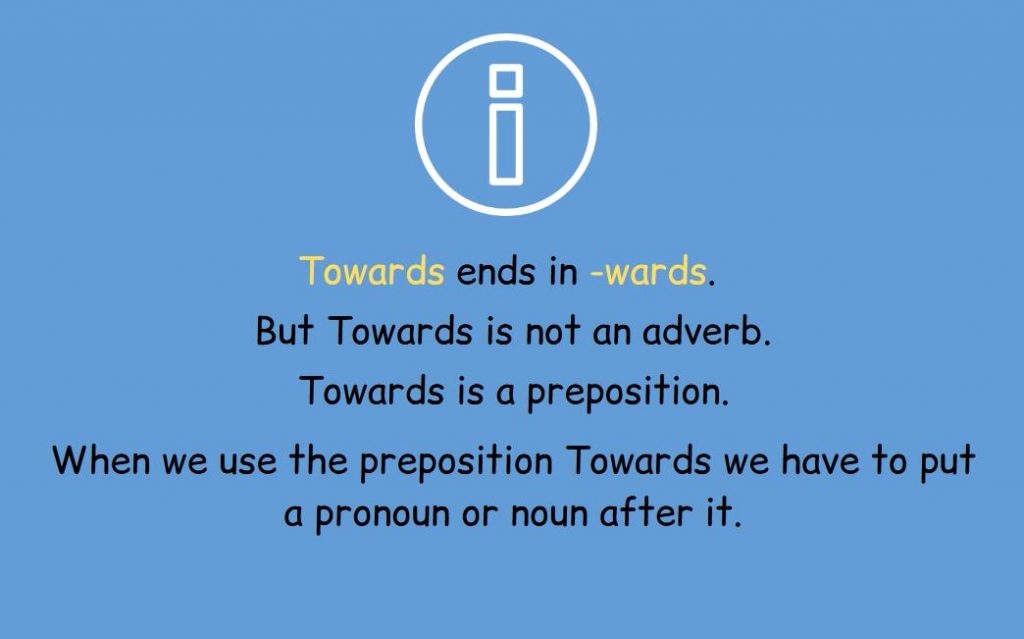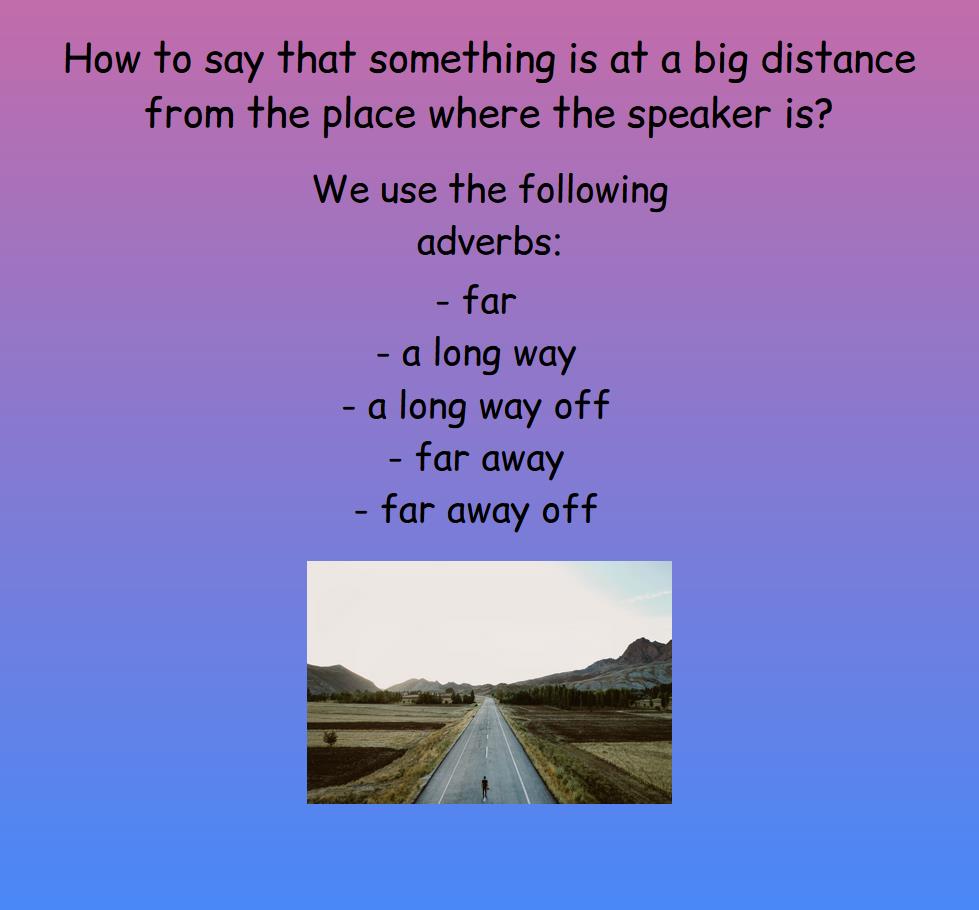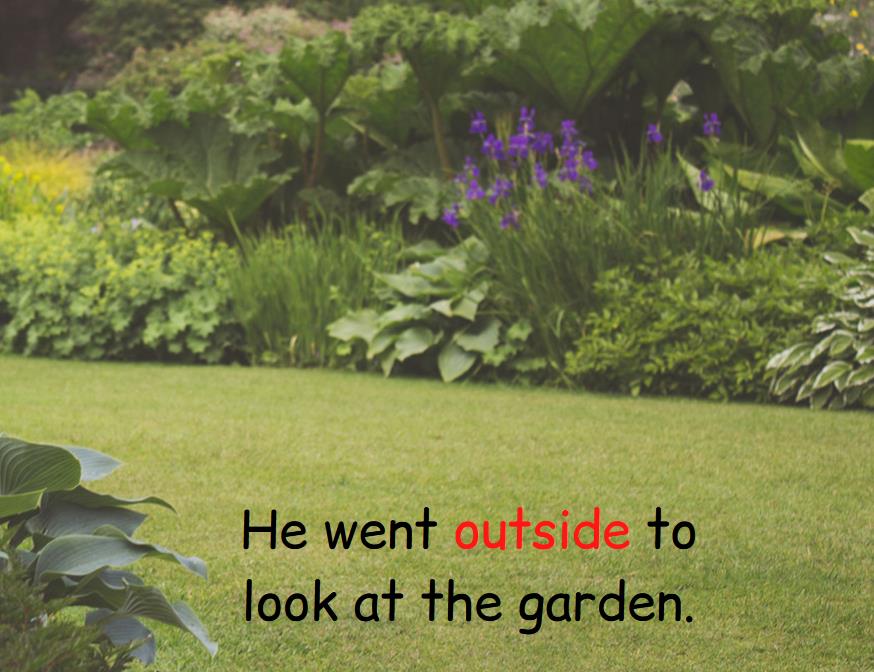Adverbs of place describe a verb to indicate a place of action or a direction of action.
- above
- ahead
- along
- anywhere
- apart
- around
- aside
- away
- back
- below
- closely
- deeply
- elsewhere
- everywhere
- far
- far away
- far off
- forth
- forward
- here
- inside
- near
- nowhere
- outside
- somewhere
- there
- where
- widely
We use the adverbs of place to indicate where an action takes place:
I remember hearing that music somewhere.
We use Adverbs of Place to indicate in which direction an action takes place.
John is rushing forward.

Place in a sentence
What place do adverbs of place take in a sentence? 🙂
We usually put these adverbs at the end of a sentence.
I never looked back.
Most often we use Adverbs of place after a verb or after the object.
But adverbs like here and there can also appear at the beginning of the sentence.
We put here or there at the beginning of the sentence when it is necessary to emphasize the place where the action takes place.
Here and There
Here and there are very common adverbs of place.

We use Here and There to form many combinations and phrases with verbs or prepositions.
Independent thought is not valued there.
Your mother said get over here.But there must be people working there.
And who else knew you were up there?
I feel like I just got here.
We often use Here and There in exclamation sentences. In such sentences, we often put Here and There at the beginning of the sentence.
Here we are!

Adverbs of place that are prepositions
We can use many adverbs of place not only as adverbs but also as prepositions.
If we use an adverb of place as a preposition, then we must put a noun after the adverb.
Adverbs of place ending in -where
We can divide many adverbs of place into groups based on their endings.
Let’s take a look at the group of adverbs that end with -where.
Usually, such adverbs do not tell us a specific location or direction, expressing them in general meaning.
I’ve seen this somewhere before.
You know him, he could be anywhere.
I think that leads nowhere.
Adverbs ending in -wards
Adverbs of place with the ending -wards do not denote a place but a movement in some direction.
Unlike chess pawns, they may move backward.
The news is spreading westwards.
We know how to turn that curve back upwards.
WARNING: Towards also ends in -wards. But Towards is not an adverb. Towards is a preposition. This means that when we use the preposition Towards we have to put a pronoun or noun after it.

Universal adverbs of place
In the English language, there is another group of adverbs we can call Universal or Multipurpose adverbs of place.
These adverbs can simultaneously denote movement and location.
Thus, they invest most of their money abroad.
Movement
We use many of the adverbs of place to indicate how we move.
We usually put these adverbs after the verb.
Now, be a gentleman and move over!
So you can move into my apartment permanently.
You can’t go off.
Direction
We use some adverbs to indicate the direction of movement. Most often, we put such adverbs after verbs.
I needed the money to move out.
Undefined location
Somewhere, everywhere, anywhere, nowhere is a group of adverbs that we use to denote an inaccurate, approximate location of something or someone.
Each adverb of this group has its characteristics.
We use somewhere in affirmative sentences.
I’ve seen this somewhere before.
You came here instead of hiding out somewhere.
We use anywhere in interrogative and negative sentences.
I never went anywhere.
I can’t take you anywhere.
How do you find someone who could be anywhere?
Do you have any grown-ups anywhere?
Nowhere is an adverb that already contains a negation. So when we use nowhere we shouldn’t use other negative verbs. Because in English it is not customary to make double negation.
There was a concrete floor, and virtually nowhere to sit.
We often use nowhere in short answers.
Question: Where did you find it?
Answer: Nowhere!
We often use not … anywhere instead of nowhere.
He goes nowhere.
He does not go anywhere.
far / a long way (off) / far away (off)
How to indicate that something is at a big distance from the place where the speaker is?
In this case, we use the following adverbs:
- far
- a long way
- a long way off
- far away
- far away off

Let’s take a closer look at these adverbs.
Far.
We use the adverb far in questions and negatives.
The apple never falls far from the tree.
Far away (off).
We use far away or far away off in interrogative and negative sentences.
We use far away or far away off when we focus on a very long distance.
His voice sounded faint and far away.
A long way (off).
We use a long way or a long way off in affirmative sentences.
Florida was a long way off.
We’ve come a long way.

Examples of sentences with adverbs of place
Look at examples of different adverbs of place in sentences.
Don’t go near the edge – it isn’t safe.
He lives nearby and sees his son several times a week.
He went outside to look at the garden.
Christmas seemed a long way off.
It’s difficult to see nearby in a sentence.
It appears he has plenty of loyalty to go around.
He is nowhere to be seen.

Hello! If you would like to thank me for the articles I wrote, you can click Buy me a coffee. Thank you! ❤❤❤










